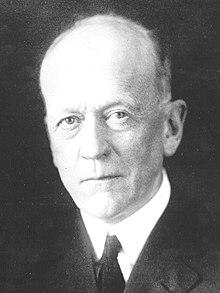American paleontologist and 4th Secretary of the Smithsonian (1850-1927) From Wikipedia, the free encyclopedia
Charles Doolittle Walcott (March 31, 1850 – February 9, 1927) was an American geologist and invertebrate paleontologist. He became known for his discovery in 1909 of well-preserved fossils in the Burgess Shale of British Columbia, Canada.
Charles D. Walcott | |
|---|---|
 | |
| Born | March 31, 1850 New York Mills, New York State, USA |
| Died | February 9, 1927 (aged 76) |
| Nationality | United States |
| Awards | Mary Clark Thompson Medal (1921) |
| Scientific career | |
| Fields | Paleontology |
| Institutions | US Geological Survey Smithsonian Institution |

Walcott became Director of the U.S. Geological Survey 1894–1907, and Secretary of the Smithsonian Institution, 1907–1927. He discovered a number of important fossil sites. At the Walcott Quarry, the lowest (earliest) of the Burgess Shale deposits, Walcott collected 65,000 specimens between 1910 and 1924. The site dates to the Middle Cambrian, and is in the Canadian Rockies.[1]
The Walcott-Rust quarry is near Russia, New York. This site has produced some of the best preserved trilobites ever found, including enrolled specimens with soft body parts.
Seamless Wikipedia browsing. On steroids.
Every time you click a link to Wikipedia, Wiktionary or Wikiquote in your browser's search results, it will show the modern Wikiwand interface.
Wikiwand extension is a five stars, simple, with minimum permission required to keep your browsing private, safe and transparent.